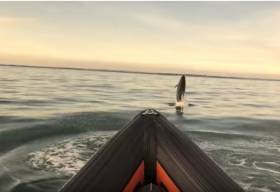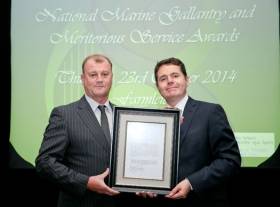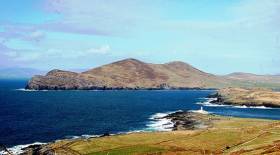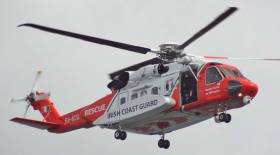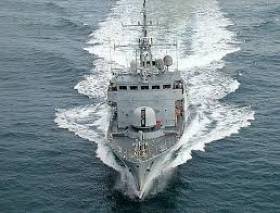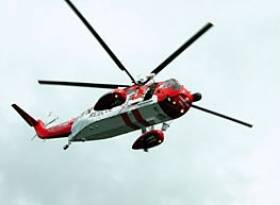Displaying items by tag: Coast Guard
Watch Officer in the Irish Coast Guard (IRCG) – Job Vacancies
The Irish Coast Guard, a Division of the Department of Transport, Tourism and Sport has vacancies for Watch Officers at its three Rescue Coordination Centres in Dublin, Malin Head, Co Donegal and Valentia, Co Kerry. The IRCG provides a nationwide maritime emergency service as well as a variety of services to shipping and other government agencies.
Watch Officers are responsible for watch-keeping on the emergency frequencies and are required to act as Marine Alert, Notification and Search and Rescue Mission Coordination Officers. They also process marine communication traffic and respond to ship casualty, pollution incidents and vessel traffic monitoring.
The Closing date for receipt of completed applications is 3.00pm on Thursday, 5th January, 2017
For more information and to make an application please visit www.publicjobs.ie.
Download the press advertisement PDF below.
Coast Guard RIB Gets Unexpected Company off Howth (VIDEO!)
The Howth–based Coast Guard boat “Sean A Dunne” was joined by some unexpected visitors today in the form of a school of Bottlenose Dolphins.
The Coast Guard crew of four from Howth station were on routine exercise in the Irish Sea off Donabate, Co Dublin in what was flat calm clear conditions.
The dolphins joined the crew surfing the bow waves of the Coast Guard boat before heading back to deeper waters.
Nominations Sought for National Marine Gallantry & Meritorious Service Awards 2016
Department of Transport, Tourism & Sport is inviting nominations in respect of the National Marine Gallantry and Meritorious Service Awards 2016. The purpose of this awards scheme is to recognise outstanding acts of courage, heroism, skill and initiative in the context of marine emergency incidents. The scheme also recognises exceptional dedication to duty in the execution of Ireland’s marine emergency response. The Marine Gallantry award is presented in the form of a medal (called the Michael Heffernan Medal for Marine Gallantry, in memory of an individual who lost his life during a marine incident a number of years ago). Three levels of medal may be awarded, based on the level of gallantry involved. The medal is awarded in gold, silver or bronze.
A second award, Marine Meritorious Service Medal, may be awarded where outstanding meritorious service has been provided to, or within the remit of, the Irish Coast Guard. The person must have demonstrated exceptional dedication to duty, coupled with skill and initiative, in the execution of the service being provided.
A Marine Ministerial Letter of Appreciation may be awarded for meritorious service where outstanding dedication to duty over a career of service can be demonstrated, or for an act of particular meritorious dedication, showing skill and initiative, but which is not of an order for receipt of a Meritorious Service Medal.
The National Marine Gallantry and Meritorious Service Awards Committee is chaired by Mr Bryan Dobson of RTE. Members of the Committee include representatives of the following, the Irish Sailing Association, Irish Water Safety, Irish Harbour Masters Association, Bord Iascaigh Mhara, Department of Transport, Tourism and Sport as well as other independent members. The National Marine Gallantry and Meritorious Awards Committee will adjudicate upon the nomination received.
The first award ceremony took place in February 1999 and the awards ceremony was last held on 23rd October 2014. In this round of Awards, nominations may be considered in respect of events occurring during the period 31st August 2014 to 31st August 2016.
Details of the Awards scheme, including nomination form, are available on the Department’s website www.dttas.ie/maritime/english/marine-awards. Completed nomination forms should be submitted by Friday 9th September 2016. The submission should be comprehensive and include all relevant information (e.g. eye-witness statements, official reports, maps, charts, photographs, newspaper cuttings etc.).
2014 Award Recipients
Mr Tony McNamara and Mr. Patrick McNamara - Marine Ministerial Letters of Appreciation for Meritorious Service
Mr Ben Graham, Mr David Grant and Mr. Alexander May - Marine Ministerial Letter of Appreciation for Meritorious Service
Drogheda Coast Guard Unit - Marine Ministerial Letter of Appreciation for Meritorious Service
Mr Michael O’Regan and the crew of the Goleen Coast Guard Unit - Marine Ministerial Letter of Appreciation for Meritorious Service
Mr Jim Griffin – Marine Ministerial Letter of Appreciation for Meritorious Service
Mr Damien Dempsey – Marine Ministerial Letter of Appreciation for Meritorious Service
Mulroy Coast Guard Unit – Michael Heffernan Bronze Medal for Marine Gallantry
I reported in detail the two battles which the people of Valentia fought against the Department of Transport and the Coast Guard to prevent the closure of the Coastal Radio Station on the Kerry island.
Valentia is fortunate to be linked by a bridge to the mainland, but has still suffered from emigration and deprivation which neglect by the State can cause to isolated communities.
I have a great respect for island people. They have to overcome difficulties and obstacles in their daily lives that those living ashore will not encounter.
Those battles and, at the same time, that of the people of Malin at the other end of the country, to prevent the closure of the Malin Head Coastal Radio Station came to my mind in the context of a technological development which changed the world and started in Valentia.
The Department, of which the Coast Guard is part - an indication of the unfortunate dispersal of maritime matters amongst too many Government Departments in Ireland - wanted to centralise operations in Dublin. In the course of my reportage, I discovered that their proposed location was in the constituency of their then Minister. Curious! Another proposed retrenchment from the regions into Dublin. There was little to justify the plan.
The people of Valentia mounted a particularly strong case against the proposal, backed by research and technological facts. Malin also produced a strong case. I wonder about the attitude of officials based in Dublin who come up with proposals like this.
These topics came up for discussion again when I attended the 150th anniversary of the laying of the first successful TransAtlantic communications cable from Valentia to Newfoundland. The laying of the cable began on July 13, 1886 when the biggest ship in existence at the time, the Great Eastern, sailed from Valentia. It arrived in Newfoundland on July 27, 1886 having laid 2,000 miles of cable weighing 9,800 tons across the Atlantic.
“The Valentia cable of 1866 changed the world,” writes Dr. Donard de Cogan in his book - ‘They talk along the deep,’ the story of cable history which was launched at the island ‘cable festival.’ “To put a cable across the ocean in the 19th century was cutting edge. These people were stretching beyond the technology of that time.” So says Bernard S.Finn. Curator Emeritus of the Electricity Collections at the Smithsonian Institution's National Museum of American History, Washington D.C.
In this edition of my programme, I talk to Anthony O’Connell, Director of Valentia Island Development Company, about the island community’s attempts to gain UNESCO recognition for the island as a World Heritage Site, a case based on the technological breakthrough which started there. Ireland has only two out of 1,000 World Heritage Sites in Europe. England, Spain and Italy have between 30 to 40 World Heritage sites each! It is a revelation to hear of the extensive research and campaign work done by the people of Valentia.
On reflection, the Department of Transport and Coast Guard were unwise to take on the people of Valentia!
• Listen to the programme above
Father & Son Kayakers Rescued in Co Galway
A father and son were rescued today, having being washed overboard from their kayak, thanks to the vigilance of Beach Lifeguards based at Tracht / Kinvarra.
Lifeguards Mark Buckley and Niall Hanley contacted the Coast Guard shortly after 3pm this afternoon when they became concerned about two kayakers who had set out earlier from Tracht beach. Valentia Coast Guard station immediately launched a search operation; tasking Galway Bay RNLI, R115 the Shannon based Coast Guard helicopter, and Doolin Coast Guard unit. Less than one hour after the alert was raised R115 located the casualties. They were then recovered by Galway Bay lifeboat who confirmed that casualties were safe and well.
Coast Guard Watch officers on duty in Valentia were highly complementary of the two local Lifeguards highlighting their vigilance, timeliness of their report and for piecing together information on the casualties. Galway Bay RNLI were also complimented for the successful rescue.
CoastGuard IMSARC Demo a Success Off Donegal
The Irish Coast Guard co-ordinated a very successful Marine Search and Rescue demonstration yesterday, Saturday 16th July. As Afloat.ie reported previously, the exercise in Moville Co Donegal involved some of Ireland’s principal Search and Rescue resources. Participants included Donegal based volunteer Coast Guard units, the Sligo based Coast Guard Rescue Helicopter, Naval ship LÉ Orla, Air Corps Casa, RNLI’s new Shannon Class All Weather Lifeboat, Bord Iascaigh Mhara, UK Maritime Coastguard Agency, Irish Water Safety, Mountain Rescue Ireland and the Civil Defence.
Speaking after the event Gerard O’Flynn, the Coast Guard’s Search and Rescue Operations Manager said: ‘This exercise afforded the public a wonderful opportunity to see Ireland’s search and rescue resources conducting a series a realistic but challenging tasks, more importantly it enabled the Coast Guard to exercise interoperability between the different assets.”
The event included a series of water based safety demonstrations.
“Prevention and adherence to basic safety is the key element in minimising loss of life at sea and on our waterways”, concluded SARs Manager Gerard O’Flynn.
The main events:
Mud rescue demonstration by nearby members of the Maritime Coastguard Agency, Bay Field in the low water river bed.
The Donegal Mountain Rescue team along with their colleagues in the Civil Defence also at Bay Field displayed their new Drone
Greencastle Coast Guard unit executed a number of cliff rescue displays.
Rescue 115, the Sligo based rescue helicopter along with the crew of LÉ Orla completed a number of winching exercise. From the deck of LÉ Orla and a “wet” lift.
The Air Corps Casa demonstrated the use of airborne life rafts as well as conducting communications exercises with air and surface resources.
Over the course of the day, Volunteer Coast Guard units from Donegal, Mulroy, Killybegs, Greencastle and Bunbeg completed number of rescue manoeuvres including - man over board, swimmer/paddle board in difficult, fishing vessel on fire.
Coast Guard, RNLI & Irish Water Safety Issue Caution
The Irish Coast Guard, the RNLI and Irish Water Safety advise caution to those engaged in recreational activities in or near water during the current spell of good weather and throughout the summer months.
There has been a significant rise in maritime recreational incidents over the weekend due to the good weather.
At this time of the year as the secondary school term comes to a close and the fine weather is upon us, members of the public are urged to take care when engaging in aquatic activities.
Chief of Operations, Coast Guard Eugene Clonan, said “there has been a noticeable increase in the number of calls over the weekend. Sunday was particularly busy with twenty three calls in response to maritime recreational incidents and he urged members of the public, particularly younger people to exercise caution in and around the water”.
Gareth Morrison RNLI Lifesaving Delivery Manager said, ‘As the weather improves we notice an increase in callouts for our lifeboats. Many of these incidents relate to leisure activities where a nice day out has unfortunately ended in a call for help. Seeking some simple advice before you take to the water or coastline could make all the difference. Our volunteer lifeboat crews are always on call but when every second counts in an emergency you need to be prepared. The RNLI urges everyone to Respect the Water.’
Roger Sweeney, Deputy CEO of Irish Water Safety said that “Ireland averages eleven drownings every month and that constant responsible child supervision will help prevent further tragedies. Parents should check that their local primary school is teaching Irish Water Safety’s classroom based curriculum that instils good habits for a safe summer ahead.”
• The temperature of the sea, lakes, canals and inland water ways is still pretty cold and waters users should exercise caution and be aware of cold water shock and hypothermia.
• Swim with others, never alone, close and parallel to shore.
• If walking on the beach be careful that you are not cut off by the tide. Seek local information about stranding risks.
• Members of the public using recreational craft at the beginning of the season should check the seaworthiness of their craft before launching, particularly engines.
• When departing check the weather forecast, tell someone where you are going and when expected back and wear a life jacket when going afloat.
• For further information on safety on the water check www.safetyonthewater.ie.
• If you see someone in difficulty in the sea, on the shore, cliffs, lakes or rivers dial 999/112 and ask for the Coast Guard.
Yachtsman Rescued off the Coast of Scotland
Just after midnight (16 February) the UK Coastguard received a Mayday emergency call from a yacht which was in difficulties and had run aground near Skerryvore Light, near the Isle of Tiree off the west coast of Scotland. There was one man on board with no reported injuries.
A Mayday relay was broadcast by the Coastguard requesting assistance and a commercial cable laying vessel made its way to the area and provided some shelter from the weather.
The Islay RNLI all-weather lifeboat was sent and has been on scene attempting to secure a line to the vessel since 3:30am. Barra RNLI Lifeboat has also been sent to assist.
The UK Coastguard search and rescue helicopter based at Prestwick successfully airlifted the yachtsman to safety just after midday. He does not require any medical attention.
UK Coastguard Maritime Operations Controller, Angus MacIver said: 'The winds in the area were gusting at severe gale force with extremely rough seas which created a very testing environment in which this rescue could be carried out. The yachtsman is now being airlifted ashore and the RNLI lifeboats are returning to base.'
Coast Guard On Long Range Medevac of Injured Russian Crewman
The Shannon based Coast Guard helicopter, R115, evacuated an injured crewman from a Russian vessel, the Armenak Babaev (110metres in length), approximately 150 miles West of Valentia, Co. Kerry last night. The injured man was airlifted at 17.45hrs to Cork Airport for onward transfer to Cork University Hospital for medical attention.
Top Cover communications, which is required for long distance helicopter communications, is being provided by an Air Corps Casa.
The operation is being coordinated by the Coast Guard Rescue Coordination centre in Valentia, who received the request earlier today when the vessel was over 200 miles from the coast. It is understood that the patient suffered burn related injuries in an engine room accident
Howth Coastguard Recruiting Volunteers as Cliff Rescue Climbers, Coastal Search & Boat Crew
The Irish Coast Guard Unit based on the West Pier in Howth Harbour is looking for volunteers.
The Unit is interviewing to fill trainee positions as Cliff Rescue Climbers, Coastal Search and Boat Crew. No experience is necessary.
All training, certifications, and the required personal equipment is provided. Volunteers are expected to live within minutes of Howth, carry a pager 24/7 to be available for callouts, and attend weekly training.
For more information, email [email protected]





























